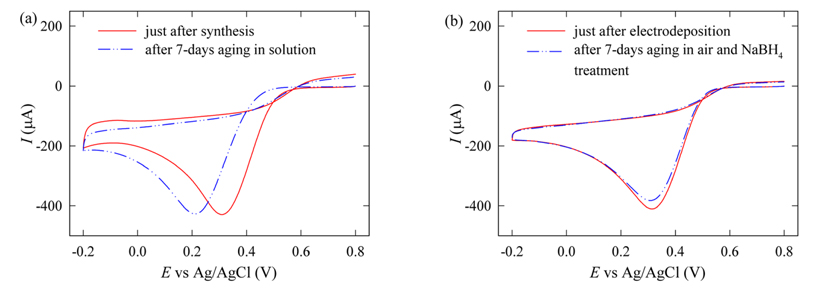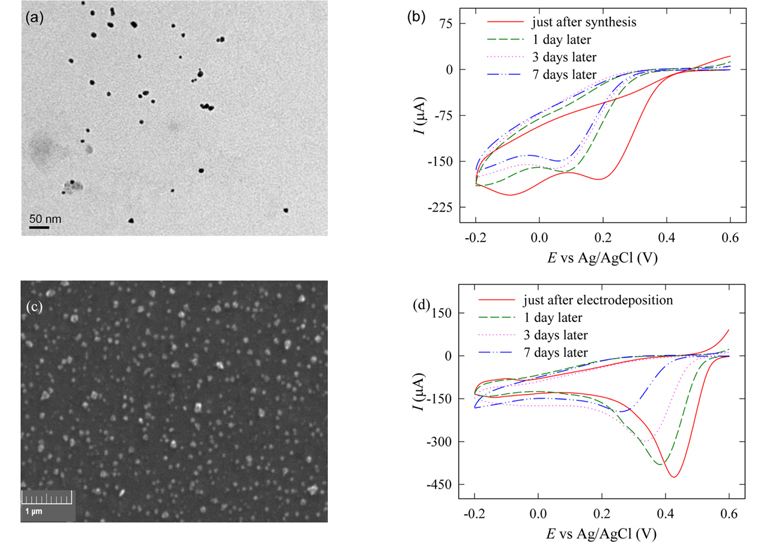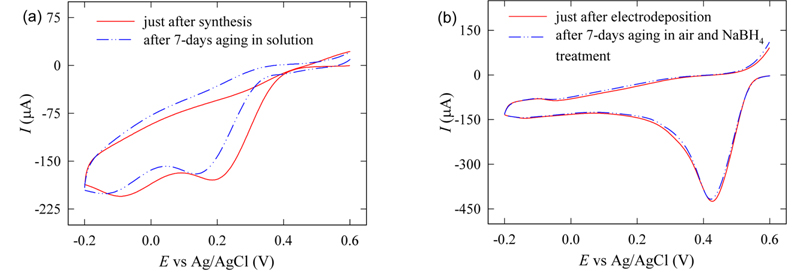[1] F. Godínez-Salomón, E. Arce-Estrada and M. Hallen-López, Int. J. Electrochem. Sci., (2012), 7, 2566.
[2] A. Datta, S. Kapri and S. Bhattacharyya,
Green Chem.,
(2015),
17, 1572.

[3] M. K. Debe, Nature, (2012), 43, 486.
[4] A. Sáez, J. Solla-Gullón, E. Expósito, A. Aldaz and V. Montiel, Int. J. Electrochem. Sci., (2013), 8, 7030.
[5] H. J. Park and S. H. Hur,
J. Korean Electrochem. Soc.,
(2014),
17, 201.

[6] E. Spain, H. McArdle, T. E. Keyes and R.-J. Forster,
Analyst,
(2013),
138, 4340.

[7] S. H. Lim, J. Wei, J. Lin, Q. Li and J. K. You,
Biosens. Bioelectron.,
(2005),
20, 2341.

[8] M. Rashid, T.-S. Jun and Y. S. Kim,
J. Korean Electrochem. Soc.,
(2014),
17, 18.

[9] V. T. T. Ho, C.-J. Pan, J. Rick, W.-N. Su and B.-J. Hwang,
J. Am. Chem. Soc.,
(2011),
133, 11716.

[10] S. Y. Ang and D. A. Walsh,
Appl. Catal., B,
(2010),
98, 49.

[11] V.-D. Dao and H.-S. Choi,
Electrochim. Acta,
(2013),
93, 287.

[12] R. C. Cerritos, M. Guerra-Balcázar, R. F. Ramírez, J. Ledesma-Garcia and L. G. Arriaga,
Materials,
(2012),
5, 1686.

[13] B. N. Wanjala, B. Fang, J. Luo, Y. Chen, J. Yin, M. H. Engelhard, R. Loukrakpam and C.-J Zhong,
J. Am. Chem. Soc.,
(2011),
133, 12714.

[14] J. Bao, M. Dou, H. Liu, F. Wang, J. Liu, Z. Li and J. Ji,
ACS Appl. Mater. Interfaces,
(2015),
7, 15223.

[15] S. Garbarino, A. Pereira, C. Hamel, E´. IrissouE´., M. Chaker and D. Guay,
J. Phys. Chem. C,
(2010),
114, 2980.

[16] G. He, Y. Song, X. Kang and S. Chen,
Electrochim. Acta,
(2013),
94, 98.

[17] J. Das, H. Kim, K. Jo, K. H Park, S. Jon, K. Lee and H. Yang, Chem. Commun., (2009), 6394.
[18] H. J. Kang, S. Patra, J. Das, A. Aziz, J. Jo and H. Yang,
Electrochem. Commun.,
(2010),
12, 1245.

[19] G. Dutta, K. Jo, H. Lee, B. Kim, H. Y. Woo and H. Yang,
J. Electroanal. Chem.,
(2012),
675, 41.

[20] G. Dutta, A.-M. Jiaul and H. Yang,
Electrochim. Acta,
(2014),
141, 319.

[21] M. Huang, Y. Shao, X. Sun, H. Chen, B. Liu and S. Dong,
Langmuir,
(2005),
21, 323.

[22] M. S. El-Deab, F. Kitamura and T. Oshsaka,
J. Electrochem. Soc.,
(2013),
160, F651–651.













